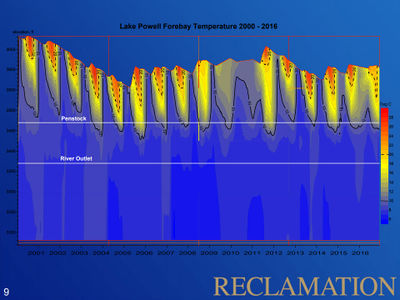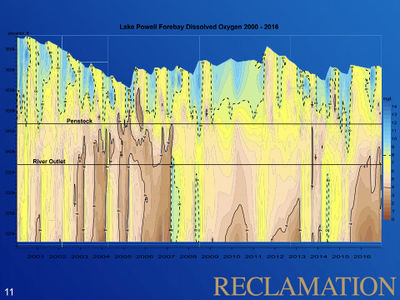|
|
| Line 47: |
Line 47: |
| | |style="color:#000;"| | | |style="color:#000;"| |
| | | | |
| − | |-
| |
| − | ! <h2 style="margin:0; background:#cedff2; font-size:120%; font-weight:bold; border:1px solid #a3b0bf; text-align:left; color:#000; padding:0.2em 0.4em;">2017 Water Quality PEP</h2>
| |
| − | |-
| |
| − | |style="color:#000;"|
| |
| | | | |
| − | *[[Media:GCMRC QW Review Agenda - Oct 2017 Final.docx| 2017 Water Quality PEP Agenda]]
| |
| − | *[[Media:Water Quality Prospectus Final 9-15-2017.docx| 2017 Water Quality PEP Prospectus]]
| |
| − |
| |
| − | ==Reading List==
| |
| − | '''Adaptive Management'''
| |
| − | *[http://dx.doi.org/10.5751/ES-07621-200322 Melis et al. 2015. Surprise and Opportunity for Learning in Grand Canyon: the Glen Canyon Dam Adaptive Management Program. Ecology and Society 20(3):22.]
| |
| − | '''Calcite Coprecipitation'''
| |
| − | *[http://www.jstor.org/stable/23596748 Cohen et al. 2013. Diel phosphorus variation and the stoichiometry of ecosystem metabolism in a large spring-fed river. Ecological Monographs, Vol. 83, No. 2 (May 2013), pp. 155-176]
| |
| − | *[https://link.springer.com/article/10.1007%2Fs10533-015-0156-6 Corman et al. 2015. Stoichiometric impact of calcium carbonate deposition on nitrogen and phosphorus supplies in three montane streams. Biogeochemistry.]
| |
| − | *[http://onlinelibrary.wiley.com/doi/10.1002/ecm.1229/abstract Corman et al. 2016. Calcium carbonate deposition drives nutrient cycling in a calcareous headwater stream. Ecological Monographs, 86(4), 2016, pp. 448–461]
| |
| − | *[http://www.nrcresearchpress.com/doi/abs/10.1139/F09-003 Hamilton et al. 2008. Biogenic calcite–phosphorus precipitation as a negative feedback to lake eutrophication. Can. J. Fish. Aquat. Sci. 66: 343–350]
| |
| − | *[http://onlinelibrary.wiley.com/doi/10.4319/lo.1972.17.5.0763/pdf Otsuki and Wtzel. 1972. Coprecipitation of phosphate with carbonates in a marl lake. ]
| |
| − | *[[Media:Reynolds1974.pdf| Reynolds and Johnson. 1974. Major element geochemistry of Lake Powell. Lake Powell Research Project Bulletin #5.]]
| |
| − | *[http://onlinelibrary.wiley.com/doi/10.4319/lo.1978.23.4.0585/full Reynolds. 1978. Polyphenol inhibition of calcite precipitation in Lake Powell. Limnol. Oceanogr., 23(4), 1978, 585-597.]
| |
| − | '''CE-QUAL Modeling'''
| |
| − | *[[Media:Lake Powell CE-QUAL-W2 review final (1).pdf|ERM’s review of the Lake Powell CE-QUAL-W2 Model]]
| |
| − | *[http://contentdm.lib.byu.edu/ETD/image/etd1755.pdf Williams, N.T., 2007, Modeling dissolved oxygen in Lake Powell using CE-QUAL-W2: Provo, Brigham Young University, thesis.]
| |
| − | *[[Media:Williams Projecting Temp.pdf| Williams, N.T., 2007, Projecting Temperature in Lake Powell and the Glen Canyon Dam Tailrace. Proceedings of the Colorado River Basin Science and Resource Management Symposium]]
| |
| − | '''Contaminants'''
| |
| − | *[https://pubs.er.usgs.gov/publication/sir20045120 Hart et al. 2005. Physical and chemical characteristics of Knowles, Forgotten, and Moqui Canyons, and effects of recreational use on water quality, Lake Powell, Arizona and Utah: U.S. Geological Survey Scientific Investigations Report 2004–5120, 43 p.]
| |
| − | *[https://pubs.er.usgs.gov/publication/ofr20131299 Schonauer. 2014. The presence and distribution of polycyclic aromatic hydrocarbons and inorganic elements in water and lakebed materials and the potential for bioconcentration in biota at established sampling sites on Lake Powell, Utah and Arizona: U.S. Geological Survey Open-File Report 2013–1299, 28 p.]
| |
| − | *[[Media:Waddell 1993 Reconnaissance study of trace elements water sediment biota Lake Powell.pdf| Waddell and Wiens. 1993. Reconnaissance study of trace elements in water, sediment, and biota of Lake Powell. ]]
| |
| − | *[https://pubs.er.usgs.gov/publication/70148396 Walters. 2015. Mercury and selenium accumulation in the Colorado River food web, Grand Canyon, USA. Environmental Toxicology and Chemistry, Vol. 34, No. 10, pp. 2385–2394, 2015]
| |
| − | '''General Lake Powell Limnology'''
| |
| − | *[http://onlinelibrary.wiley.com/doi/10.4319/lo.1980.25.2.0219/full Gloss. 1980. Advective control of nutrient dynamics in the epilimnion of a large reservoir. Limnol. Oceanogr., 25(2), 1980, 219-228]
| |
| − | *[[Media:Johnson 1981 Oxygen depleted waters Lake Powell.pdf| Johnson and Page. 1981. Oxygen depleted waters: Origin and distribution in Lake Powell, Utah - Arizona. Proceedings of the Symposium on surface water impediments. American Society of Civil Engineers, NY.]]
| |
| − | *[http://onlinelibrary.wiley.com/doi/10.1029/WR015i004p00873/full Johnson and Merritt. 1979. Convective and Advective Circulation of Lake Powell, Utah-Arizona, During 1972-1975. Water Resources Research. 15:4]
| |
| − | *[http://www.nap.edu/catalog/1832.html Stanford and Ward. 1990. Limnology of Lake Powell and the Chemistry of the Colorado River. Colorado River Ecology and Dam Management: Proceedings of a Symposium May 24-25, 1990 Santa Fe, New Mexico. Chap 5.]
| |
| − | *[http://www.tandfonline.com/doi/full/10.1080/10402381.2017.1293756 Wildman and Vernieu. 2017. Turbid releases from Glen Canyon Dam, Arizona, following rainfall-runoff events of September 2013, Lake and Reservoir Management]
| |
| − | '''Long-term Water Quality Trends'''
| |
| − | *[http://onlinelibrary.wiley.com/doi/10.1002/hyp.211/abstract Kelly 2001. Influence of reservoirs on solute transport: A regional-scale approach. Hydrol. Process. 15, 1227–1249]
| |
| − | *[https://www.ncbi.nlm.nih.gov/pubmed/24836138 Stets. 2014. Long-term trends in alkalinity in large rivers of the conterminous US in relation to acidification, agriculture, and hydrologic modification. Sci Total Environ. 2014 Aug 1;488-489:280-9]
| |
| − | '''P Biogeochemistry'''
| |
| − | *[https://www.ncbi.nlm.nih.gov/pubmed/21520765 Wildman et al. 2011. Physical, Chemical, and Mineralogical Characteristics of a Reservoir Sediment Delta (Lake Powell, USA) and Implications for Water Quality during Low Water Level. J Environ Qual. 2011 Mar-Apr;40(2):575-86.]
| |
| − | *[https://link.springer.com/article/10.1007/BF00024907 Bostrom et al. 1988. Exchange of phosphorus across the sediment-water interface. Hydrobiologia 170: 229-244]
| |
| − | *[[Media:Hering and Wildman Final Report to Bureau of Rec.pdf| Hering and Wildman. A study of the dynamics of phosphorus associated with suspended and deposited sediments in the Colorado River delta, Lake Powell, Utah. ]]
| |
| − | *[http://datanuggets.org/wp-content/uploads/2014/06/Kinsman-Costello-et-al.-2014.pdf Kinsman-Costello et al. 2014. Re-flooding a Historically Drained Wetland Leads to Rapid Sediment Phosphorus Release. Ecosystems 17: 641–656]
| |
| − | *[https://www.indiana.edu/~microbes/publications/Kinsman-Costello_etal_2016.pdf Kinsman-Costello et al. 2016. Phosphorus release from the drying and reflooding of diverse shallow sediments]
| |
| − | *[http://onlinelibrary.wiley.com/doi/10.4319/lo.1980.25.1.0012/pdf Mayer and Gloss. 1980. Buffering of silica and phosphate in a turbid river. Limnol. Oceanogr., 25(l), 12-22]
| |
| − | *[http://www.tandfonline.com/doi/abs/10.1080/07438141.2011.632705 Wildman and Hering. 2011. Potential for release of sediment phosphorus to Lake Powell (Utah and Arizona) due to sediment resuspension during low water level. Lake and Reservoir Management, 27:4, 365-375]
| |
| − | '''USGS Data Series, Circulars, and other Reports'''
| |
| − | *[http://gcdamp.com/images_gcdamp_com/2/26/GCDAMP_FY_2017_Knowledge_Assessment-Science_Advisor_Program_Final_Report_2017-04-30.pdf GCDAMP FY 2017 Knowledge Assessment: Final Report from the Executive Coordinator for the Science Advisors Program]
| |
| − | *[https://www.usbr.gov/uc/rm/amp/twg/mtgs/14apr08/TWP_14jun06.pdf?bcsi_scan_cf0ea36431a6106e=xBHF7QVHXt6Zx5nJZ4cG0wktr3sHAAAA6aC3BQ==&bcsi_scan_filename=TWP_14jun06.pdf Glen Canyon Dam Adaptive Management Program Triennial Budget and Work Plan— Fiscal Years 2018–2020]
| |
| − | *[https://pubs.usgs.gov/of/2008/1153/ USGS Workshop on Scientific Aspects of a Long-Term Experimental Plan for Glen Canyon Dam, April 10–11, 2007, Flagstaff, Arizona]
| |
| − | *[[Media:Jones 2001 Final report PEP GCMRC IWQP.pdf| Final report of the 2001 Protocol Evaluation Panel for the Grand Canyon Monitoring and Research Center Integrated Water Quality Program (IWQP)]]
| |
| − | *[https://pubs.usgs.gov/ds/471/pdf/ds471.pdf Historical Physical and Chemical Data for Water in Lake Powell and from Glen Canyon Dam Releases, Utah-Arizona, 1964–2013]
| |
| − | *[https://pubs.usgs.gov/circ/1282/ The State of the Colorado River Ecosystem in Grand Canyon: A report of the Grand Canyon Monitoring and Research Center 1991-2004]
| |
| − | *[https://pubs.er.usgs.gov/publication/ds959 Biological Data for Water in Lake Powell and from Glen Canyon Dam Releases, Utah and Arizona, 1990–2009]
| |
| − | '''Water Quality and Glen Canyon Dam Management'''
| |
| − | *[http://onlinelibrary.wiley.com/doi/10.1890/1051-0761(2001)011%5B0644:EFEOTL%5D2.0.CO;2/full Hueftle and Stevens. 2001. Experimental flood effects on the limnology of Lake Powell Reservoir, Southwestern USA. Ecological Applications, 11(3), pp. 644–656]
| |
| − | *[https://pubs.usgs.gov/of/2010/1159/ Effects of the 2008 High-Flow Experiment on Water Quality in Lake Powell and Glen Canyon Dam Releases, Utah-Arizona]
| |
| − | '''Water Quality and Metabolism in the Colorado River below Glen Canyon Dam'''
| |
| − | *[http://azmemory.azlibrary.gov/cdm/ref/collection/statepubs/id/3854 Water quality investigation of seventeen Grand Canyon tributaries: July 2004 - May 2005]
| |
| − | *[https://pubs.er.usgs.gov/publication/70154774 Hall et al. 2015. Turbidity, light, temperature, and hydropeaking control primary productivity in the Colorado River, Grand Canyon. Limnol. Oceanogr. 60, 512–526]
| |
| − | *[http://onlinelibrary.wiley.com/doi/10.1215/21573689-1572535/full Hall et al. 2012. Air–water oxygen exchange in a large whitewater river. Limnology and Oceanography: Fluids and Environments]
| |
| − | *[http://onlinelibrary.wiley.com/doi/10.4319/lo.2004.49.6.1992/full Larned et al. 2004. Mass-transfer–limited nitrogen and phosphorus uptake by stream periphyton: A conceptual model and experimental evidence. Limnol. Oceanogr., 49(6), 1992–2000]
| |
| − | *[https://pubs.er.usgs.gov/publication/70192253 Payn et al. 2017. A coupled metabolic-hydraulic model and calibration scheme for estimating whole-river metabolism during dynamic flow conditions. Limnol. Oceanogr.]
| |
| | | | |
| | |} | | |} |
| Line 122: |
Line 61: |
| | |style="color:#000;"| | | |style="color:#000;"| |
| | | | |
| − | *[[2017 Water Quality PEP]]
| |
| | *[http://gcdamp.com/index.php?title=Nutrients Nutrients Page] | | *[http://gcdamp.com/index.php?title=Nutrients Nutrients Page] |
| | + | *[http://gcdamp.com/index.php?title=TEMPERATURE Temperature Page] |
| | + | |
| | + | |- |
| | + | ! <h2 style="margin:0; background:#cedff2; font-size:120%; font-weight:bold; border:1px solid #a3b0bf; text-align:left; color:#000; padding:0.2em 0.4em;"> Water Quality PEP Reviews </h2> |
| | + | |- |
| | + | |style="color:#000;"| |
| | + | |
| | + | *[http://gcdamp.com/index.php?title=2017_Water_Quality_PEP 2017 Water Quality PEP] |
| | + | *[[Media:Jones 2001 Final report PEP GCMRC IWQP.pdf| Final report of the 2001 Protocol Evaluation Panel for the Grand Canyon Monitoring and Research Center Integrated Water Quality Program (IWQP)]] |
| | | | |
| | |- | | |- |
| Line 173: |
Line 120: |
| | '''2005''' | | '''2005''' |
| | *[http://www.usbr.gov/newsroom/newsrelease/detail.cfm?RecordID=8041 Reclamation to continue experimental operations at Glen Canyon Dam; Efforts address low dissolved oxygen levels below dam] | | *[http://www.usbr.gov/newsroom/newsrelease/detail.cfm?RecordID=8041 Reclamation to continue experimental operations at Glen Canyon Dam; Efforts address low dissolved oxygen levels below dam] |
| − |
| |
| − | |-
| |
| − | ! <h2 style="margin:0; background:#cedff2; font-size:120%; font-weight:bold; border:1px solid #a3b0bf; text-align:left; color:#000; padding:0.2em 0.4em;"> Water Quality PEP Reviews </h2>
| |
| − | |-
| |
| − | |style="color:#000;"|
| |
| − |
| |
| − | *[[Media:Jones 2001 Final report PEP GCMRC IWQP.pdf| Final report of the 2001 Protocol Evaluation Panel for the Grand Canyon Monitoring and Research Center Integrated Water Quality Program (IWQP)]]
| |
| | | | |
| | |- | | |- |


